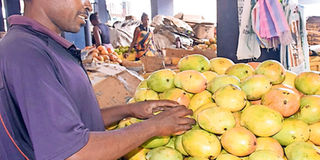To put more money in mango farmers’ pockets, we must fully embrace value addition

A trader at the Kongowea Market in Mombasa sets mangoes for sale. Appropriate storage facilities, including cold rooms, and training on pre-harvest practices that ensure high quality fruits would help farmers earn better prices. PHOTO | WACHIRA MWANGI | NMG
What you need to know:
- The fruit is a seasonal crop with high and low seasons. In most counties, mango season starts from December and peaks in January to February.
- The goal is to enable farmers attain the quality, quantity and consistency required by mango traders. Although this is expected to help farmers increase profits by negotiating for better prices, it can only work well if most farmers are in groups, thereby limiting direct sales of mangoes by individual growers.
- Efforts by some county governments in mango producing regions such as Makueni to establish juice processing plants have helped reduce postharvest losses.
- Much more can be done with mango fruits to fetch a higher value for the farmers. Unfortunately, the domestic demand for dried mango fruits is still very low.
Mangoes are the second most important fruits in the country, contributing to 21 per cent of the total value of fruits produced.
This is in comparison to bananas, which contribute 32 per cent of the total value. Owing to wide adaptation to diverse agro-ecological conditions, mangoes are produced in several counties.
The Horticultural Crops Directorate (HCD) lists the top 10 producing counties by value as Makueni (30 per cent), Machakos (23 per cent), Kilifi (16 per cent), Kwale (8 per cent), Meru (4.5 per cent), Embu (2.8 per cent), Bungoma (2.1 per cent), Tana River (1.8 per cent), Elgeyo Marakwet (1.1 per cent) and Murang’a (1.1 per cent).
Approximately, 49,098ha is under mango production, yielding about 781,000 metric tonnes (MT) valued at Sh12 billion. Most of the mangoes produced are for the domestic market. A very small percentage (less than 5 per cent) is processed or exported.
The fruit is a seasonal crop with high and low seasons. In most counties, mango season starts from December and peaks in January to February. During the peak season, there is usually an oversupply of mangoes in the domestic market.
Therefore, farm gate prices per piece fall to between Sh3 and Sh5. The fruit is highly perishable, therefore, it must be utilised (eaten fresh or processed) once it is harvested or ripened.
This scenario predisposes the mango farmers to exploitation by traders who offer them very low prices. In addition, it contributes to the high post-harvest losses (40-50 per cent) reported in the mango value chain.
There have been efforts to better farmers’ earnings and curb post-harvest losses. The University of Nairobi post-harvest project team with support from the Rockefeller Foundation is working with smallholder farmers in Karurumo (Embu County) and Masii (Machakos County) to avail low-cost cool/cold storage technologies to enable them to aggregate their mangoes and negotiate for better prices from traders.
The goal is to enable farmers attain the quality, quantity and consistency required by mango traders. Although this is expected to help farmers increase profits by negotiating for better prices, it can only work well if most farmers are in groups, thereby limiting direct sales of mangoes by individual growers.
This is because traders capitalise on the desperation of farmers during the peak season. If the farmers reject the low prices offered, the fruits will go to waste anyway, therefore, many sell at throw away price so that they don’t lose their produce.
APPROPRIATE STORAGE FACILITIES
Appropriate storage facilities (including cold rooms) and training on pre-harvest practices that ensure high quality fruits would certainly help farmers earn better prices.
This is the approach being piloted by UoN for the farmer groups in Karurumo and Masii under the Yieldwise project supported by the Rockefeller Foundation.
However, fresh fruit market is not the only option for mango farmers. There is even better value from processing the fruits into shelf-stable products, especially the dried ones.
Efforts by some county governments in mango producing regions such as Makueni to establish juice processing plants have helped reduce postharvest losses.
However, the price paid per kilo of mango (Sh10 — Sh15) is still far too low to make a major difference in the lives of farmers.
The returns — Sh10,000 to Sh15,000 per metric tonne — are even much lower than what farmers would make from sales of high quality fruits. Ms Betty Kibaara, associate director at the Rockefeller Foundation, notes in an analysis that juice processors make about Sh11,700 per MT while sales of fresh mangoes yield approximately Sh28,400 per MT.
According to Ms Kibaara’s paper, there is much higher value from drying mangoes which would yield approximately Sh440,000 per MT (conversion of fresh to dried fruit is approximately 10:1). The challenge then is for the county governments in major mango producing regions, including Makueni, Machakos and Kilifi, to look beyond juice processing.
Much more can be done with mango fruits to fetch a higher value for the farmers. Unfortunately, the domestic demand for dried mango fruits is still very low.
Therefore, most of the private companies involved in mango drying target the export market. There is a misconception among consumers that dried fruits and vegetables are not as nutritious as their fresh version.
It is important to disabuse this notion among consumers because dried fruits are as nutritious as fresh ones as long as proper practices and hygiene standards are observed during preparation and drying. Subsequently, high quality dried fruit products like mango chips and mango leather should be promoted as healthy alternative snacks to foods like potato crisps.
Empowering smallholder farmers through smallholder aggregation and processing centres has potential to improve farmers’ incomes and overall livelihoods. In addition, small-scale processing can spur growth of cottage industries in rural areas, thereby contributing to industrialisation as envisioned under the ‘Big Four’ agenda.
The writer is a senior lecturer and postharvest specialist, Department of Plant Science and Crop Protection, University of Nairobi. E-mail [email protected] or [email protected]




